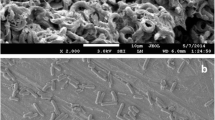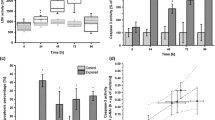Abstract
The presence of antineoplastic compounds in aquatic ecosystem is an emerging challenge for the society. Antineoplastic compounds released into the aquatic environment exhibit a potential threat to normal aquatic life. Particularly, antineoplastic compounds are responsible for direct or indirect interference with the cellular DNA of an organism and cause toxicity to cells. The present study focused on the assessment of in vitro toxic effect of cyclophosphamide, etoposide and paclitaxel on Raw 264.7 cell line (mouse monocyte macrophage cells). The inhibitory concentration of cyclophosphamide, etoposide, and paclitaxel was determined. The IC50 values of these compounds were 145.44, 5.40, and 69.76 µg ml−1 respectively. This is the first report on toxicity analysis of cyclophosphamide, paclitaxel and etoposide on Raw 264.7 cell line by reducing cell viability and indicating the cell cytotoxicity i.e., 69.58% for cyclophosphamide, 92.01% for etoposide and 88.85% for paclitaxel on concentration 250 µg ml−1. The results of their cytotoxicity assessment highlight the need of improvement in sewage treatment technology for the efficient removal of these compounds from aquatic environment.


Similar content being viewed by others
References
Bray F, Ferlay J, Soerjomataram I, Siegel RL, Torre LA, Jemal A (2018) Global cancer statistics 2018: GLOBOCAN estimates of incidence and mortality worldwide for 36 cancers in 185 countries. CA Cancer J Clin 68:394–424. https://doi.org/10.3322/caac.21492
Besse JP, Latour JF, Garric J (2012) Anticancer drugs in surface waters: what can we say about the occurrence and environmental significance of cytotoxic, cytostatic and endocrine therapy drugs? Environ Int 39:73–86. https://doi.org/10.1016/j.envint.2011.10.002
Kümmerer K, Haiß A, Schuster A, Hein A, Ebert I (2016) Antineoplastic compounds in the environment—substances of special concern. Environ Sci Pollut Res 23:14791–14804. https://doi.org/10.1007/s11356-014-3902-8
Cristóvão M, Janssens R, Yadav A, Pandey S, Luis P, Van der Bruggen B, Dubey K, Mandal M, Crespo J, Pereira V (2020) Predicted concentrations of anticancer drugs in the aquatic environment: what should we monitor and where should we treat? J Hazard Mater. https://doi.org/10.1016/j.jhazmat.2020.122330
Ferrando-Climent L, Rodriguez-Mozaz S, Barceló D (2014) Incidence of anticancer drugs in an aquatic urban system: from hospital effluents through urban wastewater to natural environment. Environ Pollut 193:216–223. https://doi.org/10.1016/j.envpol.2014.07.002
Isidori M, Lavorgna M, Russo C, Kundi M, Žegura B, Novak M, Filipič M, Mišík M, Knasmueller S, de Alda ML (2016) Chemical and toxicological characterisation of anticancer drugs in hospital and municipal wastewaters from Slovenia and Spain. Environ Pollut 219:275–287. https://doi.org/10.1016/j.envpol.2016
Azuma T (2018) Distribution of Anticancer Drugs in River Waters and Sediments of the Yodo River Basin, Japan. Appl Sci 8:2043. https://doi.org/10.3390/app8112043
Martín J, Camacho-Muñoz D, Santos JL, Aparicio I, Alonso E (2014) Occurrence and ecotoxicological risk assessment of 14 cytostatic drugs in wastewater. Water Air Soil Pollut 225:1896. https://doi.org/10.1007/s11270-014-1896-y
Orias F, Perrodin Y (2013) Characterisation of the ecotoxicity of hospital effluents: a review. Sci Total Environ 454:250–276. https://doi.org/10.1016/j.scitotenv.2013.02.064
Zhang J, Chang VW, Giannis A, Wang JY (2013) Removal of cytostatic drugs from aquatic environment: a review. Sci Total Environ 445:281–298. https://doi.org/10.1016/j.scitotenv.2012.12.061
Yadav A, Pandey S, Mandal MK, Dubey KK (2020) Development of cost-effective RP-HPLC methods for detection of cyclophosphamide, etoposide and paclitaxel. Sep Sci Plus. https://doi.org/10.1002/sscp.201900071
Elersek T, Milavec S, Korošec M, Brezovsek P, Negreira N, Zonja B, de Alda ML, Barceló D, Heath E, Ščančar J (2016) Toxicity of the mixture of selected antineoplastic drugs against aquatic primary producers. Environ Sci Pollut Res 23:14780–14790. https://doi.org/10.1007/s11356-015-6005-2
Russo C, Lavorgna M, Česen M, Kosjek T, Heath E, Isidori M (2018) Evaluation of acute and chronic ecotoxicity of cyclophosphamide, ifosfamide, their metabolites/transformation products and UV treated samples. Environ Pollut 233:356–363. https://doi.org/10.1016/j.envpol.2017.10.066
Česen M, Eleršek T, Novak M, Žegura B, Kosjek T, Filipič M, Heath E (2016) Ecotoxicity and genotoxicity of cyclophosphamide, ifosfamide, their metabolites/transformation products and their mixtures. Environ Pollut 210:192–201. https://doi.org/10.1016/j.envpol.2015.12.017
Lutterbeck CA, Wilde ML, Baginska E, Leder C, Machado ÊL, Kümmerer K (2016) Degradation of cyclophosphamide and 5-fluorouracil by UV and simulated sunlight treatments: assessment of the enhancement of the biodegradability and toxicity. Environ Pollut 208:467–476. https://doi.org/10.1016/j.envpol.2015
Parrella A, Lavorgna M, Criscuolo E, Russo C, Isidori M (2015) Eco-genotoxicity of six anticancer drugs using comet assay in daphnids. J Hazard Mater 286:573–580. https://doi.org/10.1016/j.jhazmat.2015.01.012
Białk-Bielińska A, Mulkiewicz E, Stokowski M, Stolte S, Stepnowski P (2017) Acute aquatic toxicity assessment of six anti-cancer drugs and one metabolite using biotest battery–biological effects and stability under test conditions. Chemosphere 189:689–698. https://doi.org/10.1016/j.chemosphere.2017.08.174
Kumar M, Jaiswal S, Sodhi KK, Shree P, Singh DK, Agrawal PK, Shukla P (2019) Antibiotics bioremediation: perspectives on its ecotoxicity and resistance. Environ Int 124:448–461. https://doi.org/10.1016/j.envint.2018.12.065
Dubey KK, Luke GA, Knox C, Kumar P, Pletschke BI, Singh PK, Shukla P (2018) Vaccine and antibody production in plants: developments and computational tools. Brief Funct Genom 17:295–307. https://doi.org/10.1093/bfgp/ely020
Huang G-J, Deng J-S, Chen C-C, Huang C-J, Sung P-J, Huang SS, Kuo Y-H (2014) Methanol extract of Antrodia camphorata protects against lipopolysaccharide-induced acute lung injury by suppressing NF-κB and MAPK pathways in mice. J Agric Food Chem 62:5321–5329. https://doi.org/10.1021/jf405113g
Dangi AK, Sinha R, Dwivedi S, Gupta SK, Shukla P (2018) Cell line techniques and gene editing tools for antibody production: a review. Front Pharmacol 9:630. https://doi.org/10.3389/fphar.2018.00630
Huang C-Y, Ju D-T, Chang C-F, Reddy PM, Velmurugan BK (2017) A review on the effects of current chemotherapy drugs and natural agents in treating non–small cell lung cancer. Biomedicine 7:12–23. https://doi.org/10.1051/bmdcn/2017070423
Simsek C, Esin E, Yalcin S (2019) Metronomic chemotherapy: a systematic review of the literature and clinical experience. J Oncol 2019:5483791. https://doi.org/10.1155/2019/5483791
Das MT, Budhraja V, Mishra M, Thakur IS (2012) Toxicological evaluation of paper mill sewage sediment treated by indigenous dibenzofuran-degrading Pseudomonas sp. Bioresour Technol 110:71–78. https://doi.org/10.1016/j.biortech.2012.01.078
Lojk J, Repas J, Veranič P, Bregar VB, Pavlin M (2020) Toxicity mechanisms of selected engineered nanoparticles on human neural cells in vitro. Toxicology. https://doi.org/10.1016/j.tox.2020.152364
Parrella A, Kundi M, Lavorgna M, Criscuolo E, Russo C, Isidori M (2014) Toxicity of exposure to binary mixtures of four anti-neoplastic drugs in Daphnia magna and Ceriodaphnia dubia. Aquat Toxicol 157:41–46. https://doi.org/10.1016/j.aquatox.2014.09.012
Kovács R, Bakos K, Urbányi B, Kövesi J, Gazsi G, Csepeli A, Appl ÁJ, Bencsik D, Csenki Z, Horváth Á (2016) Acute and sub-chronic toxicity of four cytostatic drugs in zebrafish. Environ Sci Pollut Res 23:14718–14729. https://doi.org/10.1007/s11356-015-5036-z
CDER F (1996) Guidance for industry: single dose acute toxicity testing for pharmaceuticals (Final)
Russo C, Lavorgna M, Piscitelli C, Isidori M (2020) Toxicity of anticancer drug residues in organisms of the freshwater aquatic chain. Fate and effects of anticancer drugs in the environment. Springer, Cham, pp 379–401. https://doi.org/10.1007/978-3-030-21048-9_15
Zounková R, Odráška P, Doležalová L, Hilscherová K, Maršálek B, Bláha L (2007) Ecotoxicity and genotoxicity assessment of cytostatic pharmaceuticals. Environ Toxicol Chem 26(10):2208–2214. https://doi.org/10.1897/07-137R.1
Grung M, Källqvist T, Sakshaug S, Skurtveit S, Thomas KV (2008) Environmental assessment of Norwegian priority pharmaceuticals based on the EMEA guideline. Ecotox Environ Safe 71(2):328–340. https://doi.org/10.1016/j.ecoenv.2007.10.015
Parrella A, Lavorgna M, Criscuolo E, Russo C, Fiumano V, Isidori M (2014) Acute and chronic toxicity of six anticancer drugs on rotifers and crustaceans. Chemosphere 115:59–66. https://doi.org/10.1016/j.chemosphere.2014.01.013
Acknowledgments
This work was financially supported by Department of Biotechnology (Ministry of Science and Technology), Govt. of India [Grant No: BT/IN/INNO-INDIGO/26/MKM/2015-16]. We would also like to acknowledge Dr. Vinod Yadav (Assistant Professor, Department of Microbiology, Central University of Haryana) for guidance during experiment.
Funding
This work was financially supported by Department of Biotechnology (Ministry of Science and Technology), Govt. of India [Grant No: BT/IN/INNO-INDIGO/26/MKM/2015-16].
Author information
Authors and Affiliations
Contributions
All authors are equally contributed in this manuscript.
Corresponding author
Ethics declarations
Conflicts of interest
The authors declare that they have no known competing financial interests or personal relationships that could have appeared to influence the work reported in this paper.
Consent to participate
Not applicable.
Consent for publication
Not applicable.
Additional information
Publisher's Note
Springer Nature remains neutral with regard to jurisdictional claims in published maps and institutional affiliations.
Rights and permissions
About this article
Cite this article
Yadav, A., Mandal, M.K. & Dubey, K.K. In Vitro Cytotoxicity Study of Cyclophosphamide, Etoposide and Paclitaxel on Monocyte Macrophage Cell Line Raw 264.7. Indian J Microbiol 60, 511–517 (2020). https://doi.org/10.1007/s12088-020-00896-1
Received:
Accepted:
Published:
Issue Date:
DOI: https://doi.org/10.1007/s12088-020-00896-1




